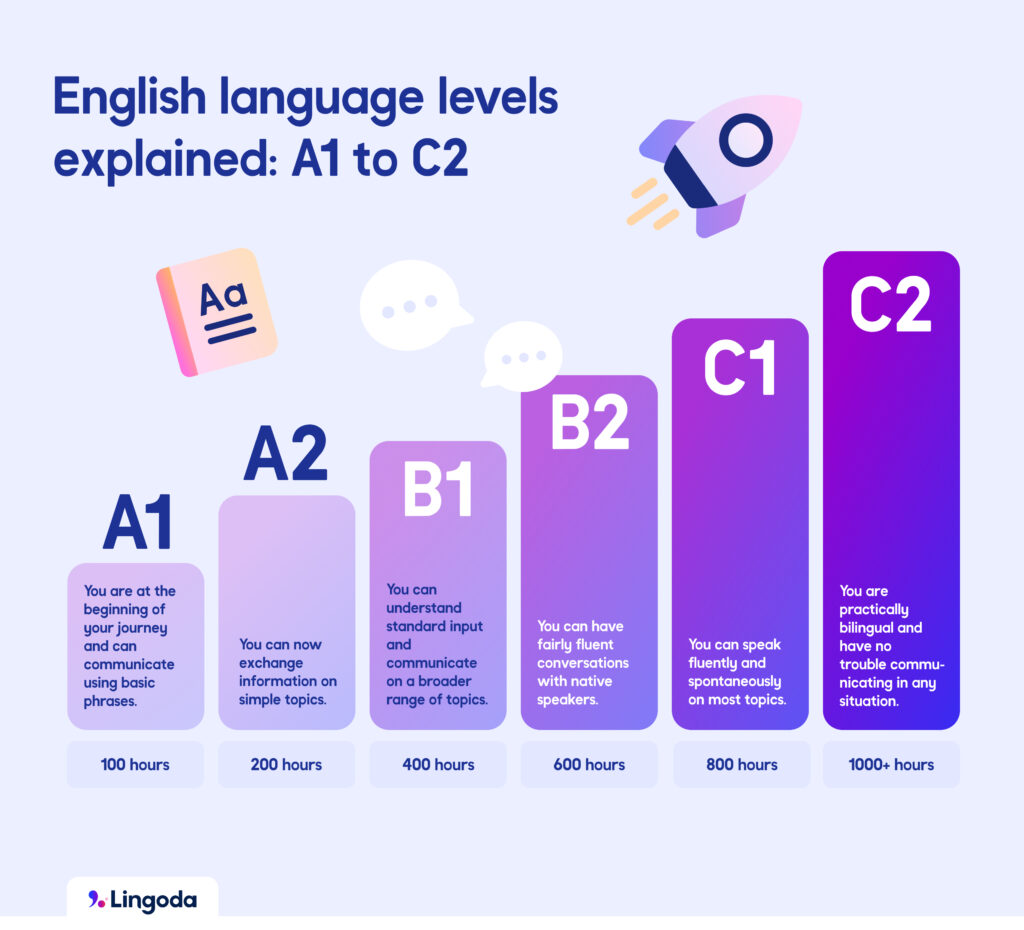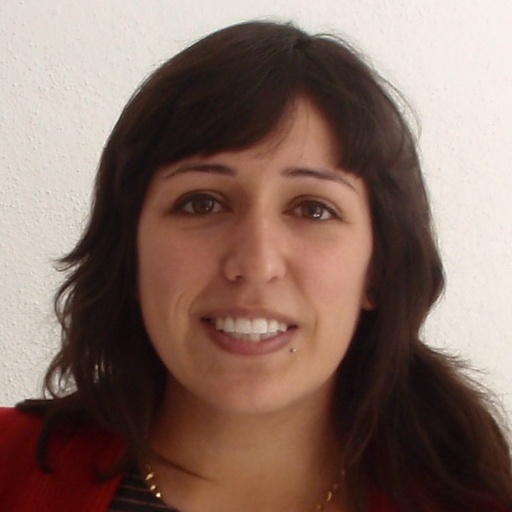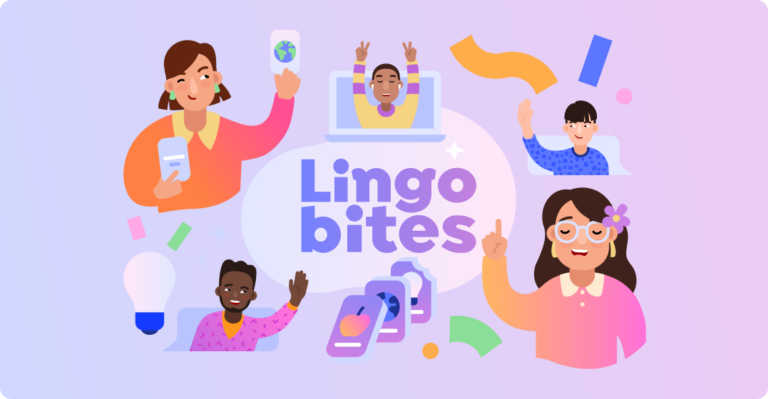Updated on January 14, 2025

English language levels explained: A1 to C2

What exactly are the CEFR English language levels? If you’re looking to start your English-language journey, chances are you’ve already bumped into them. A1, C2, B1… What does it all mean?
Let’s uncover it. The Common European Framework of Reference for Languages (CEFR) is a language proficiency scale that will help guide our studies of a foreign language. It uses a six-level scale to track progress, from A1 (beginners) to C2 (fully proficient speakers):
This framework is meant to describe different levels of language skills, and learners can use it to set their proficiency goals. Let’s explore what this is all about!

Learn English with Lingoda
How it works

What are the CEFR English language levels?
The Common European Framework of Reference for Languages (CEFR) is a globally recognized standard that measures language ability – it covers reading, speaking, listening and writing. Here are the levels in order:
A1 Level (Beginner) > A2 Level (Elementary) > B1 Level (Intermediate) >
B2 Level (Upper-Intermediate) > C1 Level (Advanced) > C2 Level (Mastery)
Say your aim is to learn English to navigate travel better or to reach an advanced level and give your curriculum vitae (resume) a boost… Knowing what CEFR level you want to achieve can help you figure out what you need to focus on and pick the right course to get there.
CEFR levels are the backbone of many English courses and textbooks. For example, language schools like Lingoda design programs around these levels to help learners improve step by step. Additionally, since the framework is recognized worldwide, it’s a handy way to show your English skills when applying for jobs, schools or other opportunities.
Pro-tip: We recommend joining courses that provide you with a certificate of completion for each level (like Lingoda!).
How do you identify your English level?
How do we identify levels of English language learners? Placement tests!
Placement tests allow us to measure our abilities and set upcoming goals. For instance, if you know that you’ve completed the A2 level, then you can enroll in a B1 course knowing you’ll be challenged (but not overwhelmed).
And where can we take a placement test? Your IELTS or TOEFL score can demonstrate your level, and both are widely accepted by employers and schools.
Pro-tip: If you’re not ready to spend a fortune on an official test, check out Lingoda’s online placement test to help you figure it out.
CEFR levels explained: From A1 to C2
Here’s the full breakdown of English language learners’ proficiency levels according to the CEFR.

A1 Level (Beginner)
At this level, you understand and use everyday phrases and basic vocabulary to express simple needs. You can introduce yourself, talk about where you’re from and ask or answer simple personal questions. Conversations are possible, but only if the other person speaks slowly and clearly – and you may need some time to come up with the right words.
- Skills gained: Can have basic interactions, write simple descriptions, get around a city by reading simple signs.
- Tips to reach A1: Try Lingoda’s A1 course, use language apps, read easy stories.
A2 Level (Elementary)
You can express your opinion on familiar topics with short sentences. You start learning past and future tenses, which means you can talk about your experiences and immediate needs. Conversations might still be brief, but you’re better at sharing details about family, work and daily life.
- Skills gained: Description of routine tasks and everyday life, as well as of immediate needs, experiences and wishes. Simple texts can be understood.
- Tips to reach A2: Regular practice with native speakers, focus on essential verbs likely to come up in everyday conversations, write short and simple descriptions of your routine to learn vocabulary.
B1 Level (Intermediate)
This is where you can handle everyday conversations with native speakers – like ordering at a restaurant or asking for directions. You can manage familiar topics in longer chats, but you might still struggle to find the right words or verb tenses. You’re not ready to work or study fully in English yet, but you can solve most day-to-day issues.
- Skills gained: Connect sentences, travel with ease, have simple discussions, watch TV with the help of subtitles, read the news.
- Tips to reach B1: Find a language exchange buddy, practice everyday, listen to podcasts in English.
B2 Level (Upper-Intermediate)
You can follow the main ideas of complex texts, speak with more fluency and have spontaneous conversations. You’ll feel confident writing and discussing different topics and you’ll have enough skills to live, work or study in an English-speaking country.
- Skills gained: Use more complex grammar, have confident discussions, understand advanced texts.
- Tips to reach B2: Write longer texts, practice your English pronunciation, talk to native speakers, watch movies without subtitles.

Learn English with Lingoda
How it works

C1 Level (Advanced)
You’ve got most of it figured out now. You can handle complex and demanding content, pick up on jokes and subtle meanings and express yourself fluently in academic or professional settings without slowing down.
- Skills gained: Produce detailed and cohesive content on nearly any topic, engage fluently in professional and academic conversations, understand nuanced ideas.
- Tips to reach C1: Join advanced courses like Lingoda’s Business English, immerse yourself in the language (watch movies, listen to podcasts, write in English), challenge yourself with increasingly demanding material.
C2 Level (Mastery)
This is the most advanced English level. You’re able to use the language with total confidence and on a similar level to a native speaker. You can express yourself effortlessly in any situation – academic, professional or casual. You’ll understand idioms, pick up on all the nuances and make arguments with ease.
- Skills gained: Understand idiomatic expressions, high-level professional and academic communication, ability to express coherent arguments about any topic, converse spontaneously with near-native fluency.
- Tips to reach C2: Join advanced debate clubs, write essays on complex topics, keep engaging with English content every day.
How do you set and achieve your English proficiency goals?
First things first – ask yourself why you’re learning English. Is it for travel? Watching shows and movies? Are you aiming to work or study abroad? Once you’ve got your “why” figured out, think about how fast you wanna get there. This will help you choose the best courses and practice routines for you.
For example, if you’re in a hurry to level up, we recommend joining sped-up programs like Lingoda Sprint. And if your goal is to hit a specific English level, Lingoda offers courses from A1 to C1 – and even Business English –, so you can dive straight into the next challenge.
Here are some more tips on how to stay on track:
- Find a schedule that works for you so you can stay consistent (hint: Lingoda Flex has you fully covered).
- Keep yourself motivated – engage with content that interests you.
- Track your progress by taking tests and challenging yourself.
- Immerse yourself in the language.
FAQs
How do I know my English proficiency level?
You can take exams like IELTS or TOEFL, or placement tests like Lingoda’s.
Is B2 English level good for university?
This will depend on the university and program, but most universities accept B2-level English for Bachelor’s degrees.
Is C1 level bilingual?
Yes, this means you’re proficient in the language and can communicate with ease.
Ready to level up your English skills?
The CEFR English language levels are a helpful tool to figure out your English proficiency, set clear goals and make progress with a structured plan. Plus, since it’s an internationally recognized framework, institutions and workplaces will know what you can do in the language from the get-go – which can give your career a boost.
So, if you’re all set to go after your goals, Lingoda has your back! With some of the smallest class sizes around, flexible scheduling and expert native-level teachers, we’re ready to join you in this journey. Let’s go!

Learn English with Lingoda
How it works














